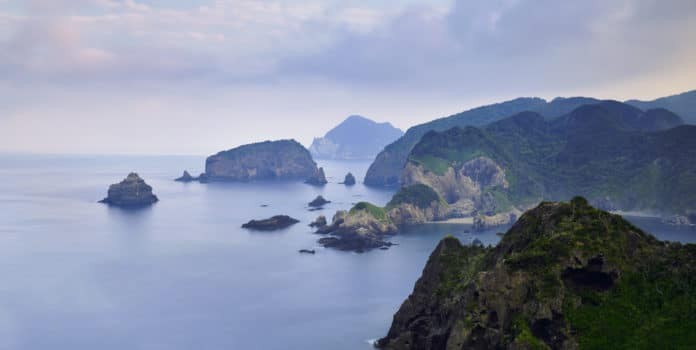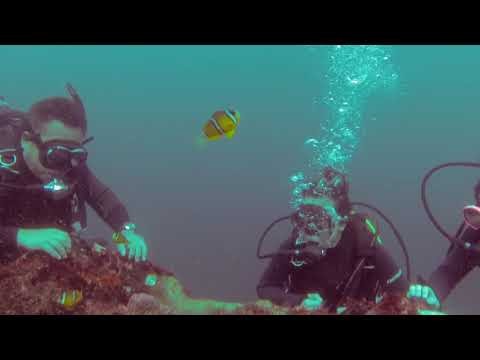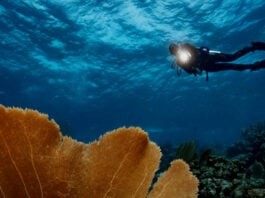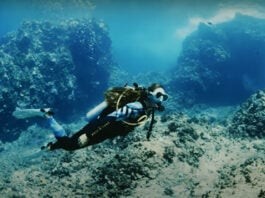If asked to name great diving destinations, Japan might not make your list, and the possibility of Tokyo making it is even less. You might also find it surprising that Japan has a very large number of certified divers, many of whom are from Tokyo. Many divers are attracted to the outstanding diving found in Okinawa Island and the other islands of the Ryukyu Islands, Japan’s tropical southern islands. While diving is great there, it is a distance from the main islands of Japan. Having some local diving is something most divers wish for.
Tokyo is located on the island of Honshu, the largest and most populous island of Japan. Around the islands, you will find divers diving year-round. The northern tip of the island is cold water diving. The Oyashio current (“Parental Tide”) starts in the Arctic circle and flows past the northern potion of the island. You will find temperate conditions and marine life here. The southern portion of the island has the Kuroshio Current, also called the “Black Tide” or the “Japan Current”. This current starts in the warm waters of the Philippines and continues north along the east coast of Japan, passing Tokyo. This current helps warm Japan and brings tropical marine life to the area.
The most popular local destination for Diver’s in Tokyo is the mountainous Izu Peninsula. The Izu Peninsula is about 100 kilometers from central Tokyo. Using a high-speed train that distance would be closed in about an hour. The Izu Peninsula has four tourism regions: the East Coast, Central Highlands, West Coast, and the Southern Coast. The coasts are famous for water actives and the highlands for the mountains and forest. Diver’s will find that there are over 60 dive centers and dive resorts in Izu. There are about 14 dive destinations on the peninsula plus some altitude diving.
Most of the dive centers in Tokyo also have trips to the Peninsula.
East Coast Diving
The east coast of Izu is a popular destination not only for scuba diving but for other activities as well. A number of the towns and cities in this region are noted for their onsen (hot spring). Many of which are along the coast. East Izu (Higashi Izu) has some of the first established dive sites in the country, which are also some of the earliest in the world. Izu is one of the leading domestic tourist destinations in Japan. You will see a few international tourists in the area. If you want a local experience, this is your best bet.
Izu Ocean Park was established in 1964, making it one of the oldest dive centers in the world. The park has pools for both dive training and swimming. Families are seen enjoying the day along the water edge. Diving, however, is the main draw. The area was designed for scuba diving with plenty of tables for camera gear and uncrowded conditions even when crowded. The park offers shore dives. There are two entry points. One that stays shallow and offers beginning divers a wonderful experience. The shallow site is a favorite among photographers. Photographers have great conditions for their craft. Visibility and water clarify provide photographers with ample light and clear waters. The other dive site is for more advance divers and slopes down to 30 meters. Both sites offer abundant marine life. After your dive keep your wet suit on and rinse it off in the onsen right in the park.
Atami is a very popular getaway destination and is renown of the onsen in the area. It is also one of the primary locations for diving in Izu. Diving in Atami is mostly done by boat, however, the dive sites are close to shore. The signature dive of Atami is the shipwreck Asahi Maru. The wreck sits in about 35 meters of water with the superstructure around 25 meters. Having been down for over two decades the ship has become an artificial reef teeming with coral, sponges and reef fish. The Asahi Maru is generally paired with one of the two pinnacle dives. Sodaine is a deep dive, while the other pinnacle reaches from 40 meters to just 12 meters below the surface.
Hayakawa is located a few stops on the train before Atami and is the first dive destination from Tokyo. Diving here is primarily shore diving and shallow. It is a great destination for macro photography.
West Coast Diving
The west coast of Izu also offers great diving. However, the public transportation infrastructure is not as good as the east coast. Divers will find a bit more walking to the dive sites.
Osezaki is likely the leading destination on the west coast. It is one of the few destinations in Japan that supports technical diving. Osezaki is located on a bay within the Suruga Bay created by the peninsula. The water here is protected from most storms. There are a number of dive sites both within and outside of the bay. There is a mix of shore diving and diving by boat. Mount Fuji can clearly be seen from the waters. Divers who enjoy night diving will find it here year round.
Ida, a small village located near Osezaki, is a fairly new destination attracting divers for about a decade. The area is noted for its shore dives to a gentle slope that leads to a 35-meter drop off. Visibility is always excellent and there is very healthy marine life.
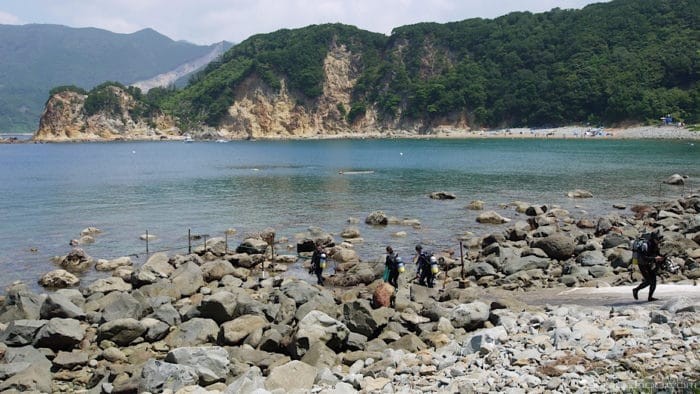
Usugu (Koganezaki Beach Park) is located within a national park. The diving is good for all skill levels but it does not go deeper than 18 meters. Visibility here is normally outstanding, with little or no currents.
Southern Izu
Southern Izu offers a different style of diving than the east and west coast. Here the divers will be faced with currents and often rough seas. If you are an experienced diver and know how to dive in currents, southern Izu may have the perfect diving for you. Mikimoto Island is located about 10 kilometers from the southern tip of Izu and at times in the Kuroshio Current. The marine life is amazing and great visibility. In the summer and fall, the area has a nickname of Hammerhead alley as hundreds of hammerhead sharks make the area their home.
Dive With The Locals
Unlike many other destinations, the dive centers and dive destinations are not focused on the tourist. Visiting divers make up only a small percentage of the divers. However, we all speak diving so it can be a great experience. Shore diving is popular so often it will be you and your dive buddy.
